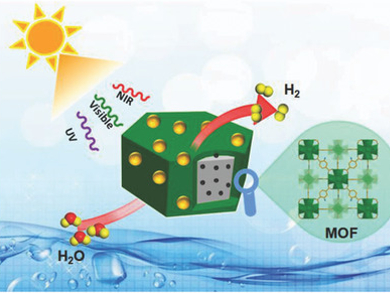The solar spectrum consists of 5 % ultra-violet (UV), 42–45 % visible, and more than 50 % near-infrared (NIR) light. Photocatalytic reactions, which convert solar energy into chemical energy, require photocatalysts that can use as much of the solar spectrum as possible.
Hai-Long Jiang, University of Science and Technology of China, Hefei, and colleagues have developed a broadband spectrum-responsive metal-organic framework (MOF) composite which captures UV, visible, and NIR light. The composite consists of a core containing lanthanide-doped upconverting nanoparticles (UCNPs, pictured grey) with the composition NaYF4:Yb, Tm, Er and platinum nanoparticles (PtNPs, pictured black). This core is surrounded by a 40 nm-thick shell composed of the MOF UiO-66-NH2 (pictured green), which is decorated with gold nanoparticles (AuNPs, pictured gold).
The MOF serves as a separator between the Au NPs and the Pt NPs and allows access to the Pt active sites for the reaction substrates. The combination of UCNPs, MOF, and AuNPs results in broadband adsorption: The MOF is responsive to UV light, the AuNPs absorb visible light, and the UCNPs absorb NIR light and emit UV and visible light. As a result, the composite has an excellent catalytic activity and produces 280 µmol g–1 h–1 of H2 when exposed to simulated sunlight.
- From UV to Near-Infrared Light-Responsive Metal-Organic Framework Composites: Plasmon and Upconversion Enhanced Photocatalysis,
Dandan Li, Shu-Hong Yu, Hai-Long Jiang,
Adv. Mater. 2018.
https://doi.org/10.1002/adma.201707377


